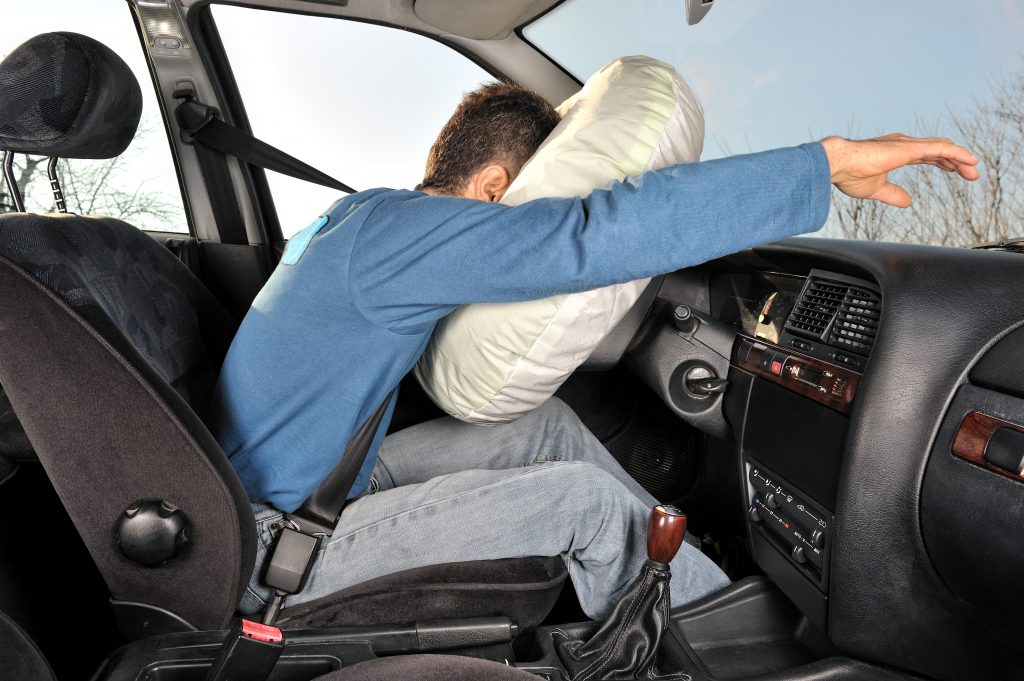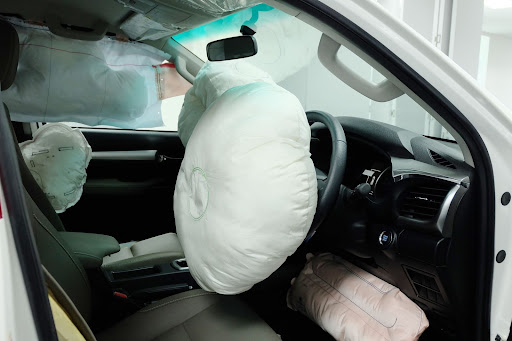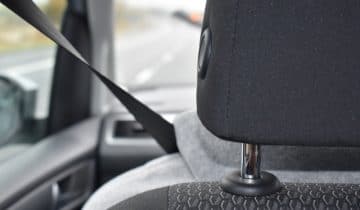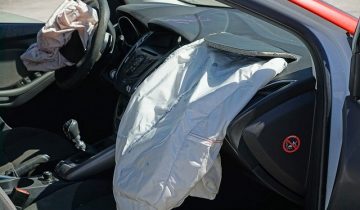Like seatbelts and improved crumple zones, airbags are one of your car’s most critical safety technologies—and they continue to be refined by safety researchers every year. Although you probably know that airbags deploy during accidents, it’s common to wonder what exactly causes them to deploy.
In this article, we’ll explain everything you need to know about what makes airbags deploy, including the types of crashes and amounts of force that most commonly cause deployment. We’ll also explain how airbags work, how they save lives, and how you can stay safe around your car’s airbags.
When Do Airbags Deploy?
Simply put, an airbag system is deployed when the car’s sensors detect a car accident. The sensors assess the severity of the car accident, instantaneously determining whether the impact is severe enough to require deployment — and if they determine it’s needed, deployment happens within a fraction of a second. Once the airbags are deployed, they instantly inflate to protect the passenger from being thrown against hard surfaces like the wheel, dashboard, window, or windshield.
Generally speaking, the threshold that front air bags will deploy for a sudden frontal crash into a rigid object (like a tree or wall) at around 10 to 14 miles per hour for unbelted front-seat occupants and approximately 16 to 18 miles per hour for belted occupants. While it varies depending on the crash sensor, they often factor in things like passenger weight, the distribution and location of impact force, and whether or not the buckle is used to determine the exact threshold for deployment.
Air bags are generally very reliable when it comes to deploying. They usually don’t require maintenance or checks unless a recall notice has been issued. Once the airbags have been deployed, you’ll need an airbag replacement. This can be done at a repair shop with the original equipment manufacturer (OEM) airbags. It’s crucial to go to a trustworthy shop and get legitimate OEM airbags to replace your deployed airbag, as counterfeit airbags can fail to deploy, explode, or even release shrapnel.
How Do Airbags Work?
Front Airbags
Front airbags are a type of protective device installed as a standard feature in all passenger vehicles produced in the United States after 1999. This includes cars, vans, and light trucks. The reason why is simple: they’re highly effective at protecting drivers and passengers from serious injury or death in crashes.
Generally, two frontal airbags are installed in the dashboard as a standard feature in passenger cars. They’re connected to smart sensors located on different vehicle parts that are made to detect impacts and assess their severity. When a car accident is detected, they instantaneously inflate and explode from the dashboard.
Side Airbags
Side airbags are a type of protective device installed in most passenger vehicles. While not every car contains side airbags, they’re generally included to comply with federal requirements for a car model’s side protection. They’re used to protect front-seat occupants from dangerous impacts with the body of the vehicle — particularly the window glass, which can easily shatter in a crash.
Because side air bags aren’t explicitly required by law, the location of an airbag module tends to vary by vehicle. Generally, they deploy between the head and window to protect the passenger’s head and neck. Since side airbags need to deploy more quickly to protect passengers, they generally have much lower deployment thresholds than other devices. The threshold can be anywhere between 8 and 20 mph, depending on the location and distribution of the impact.
Do Airbags Really Save Lives?
Yes, airbags do save lives. Studies have shown that using front airbags reduces driver fatalities by 29% and front-seat passenger fatalities by 32% in car crashes. Likewise, using side airbags to protect the head of the driver in a driver-side crash reduces the probability of death by 37%. When a driver-side crash occurs with an SUV, side airbags can reduce the likelihood of a driver fatality caused by a severe crash by 52%.
Undoubtedly, having functional airbags in your car is one of the best things you can do to stay fully protected on the road. And it’s not just front airbags you need to worry about — given that all of the vehicles given a good rating in the IIHS side crash tests are equipped with side airbags, it’s safe to say that you’ll need a car with complete air bag coverage before you’re fully protected on the road.
Can Airbags Injure You?
While airbags are known to reduce fatalities and injuries in car crashes significantly, there are certain types of injuries that airbags can cause — especially when sitting improperly inside your vehicle. You can think of it as a side effect of a life-saving medication. While any airbag injuries are an unfortunate side effect, they are preferable to the injuries and fatalities that commonly occur without airbags.
Luckily, airbags have become much safer to use with time. Aside from topics like crumple zones, a common subject for automotive safety researchers to focus on is making airbags safer for the occupants of vehicles. And due to federal laws created to encourage automakers to make airbags safer, these developments have been expedited.
Airbags now use smart technology like detecting the weight of a passenger to determine whether the airbag deployment is safe. If the sensors detect a child’s safety seat or small passenger, they use different airbag deployment patterns to ensure that the vehicle occupant won’t be injured. Airbags have also been fine-tuned to deploy with less power, ensuring they’re able to provide the same instant response with less of a punch.
Two factors can make airbags slightly more hazardous. If you have faulty or counterfeit airbags, you may be at risk of dangerous situations like unintended airbag deployment, incorrect airbag deployment timing or force, or even an explosion or burst of shrapnel resulting from a poorly made airbag. If you’re sitting improperly in your car, you may also be at higher risk of severe injury from an airbag. You should follow these tips to stay safe while in your vehicle:
- Put young children, baby seats, and small passengers in the rear seats. This will protect them from potential injury if airbags are deployed since airbags aren’t optimized to protect smaller occupants.
- Sit with your back against your seat. Your chest should be at least 10 inches away from the center of the steering wheel. If you need the seat positioned further forward, you should recline your seat until your chest is at an appropriate distance.
- Don’t lean against the window. This may interfere with the deployment of side airbags, potentially causing injury.
Final Thoughts
While driving on the open road always comes with a few risks, safety devices like airbags are generally effective at keeping you safe in a car crash. Devices like airbags and seatbelts have been so effective that they’ve significantly reduced the risk of driver and passenger fatalities and injuries.
When you rely so heavily on a safety device, it’s hard not to wonder how exactly it works — and when it deploys. We hope our article about how airbags work helped you understand everything you need to know about when airbags deploy.



